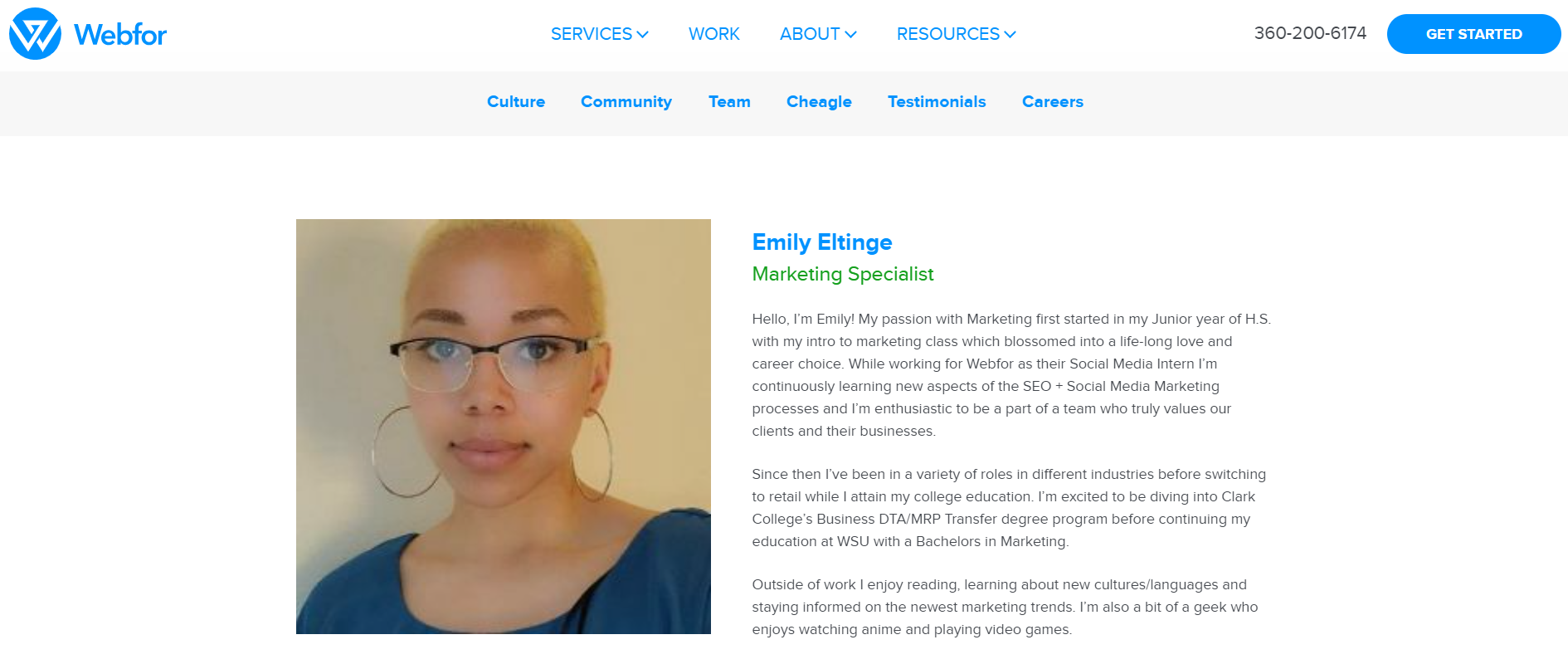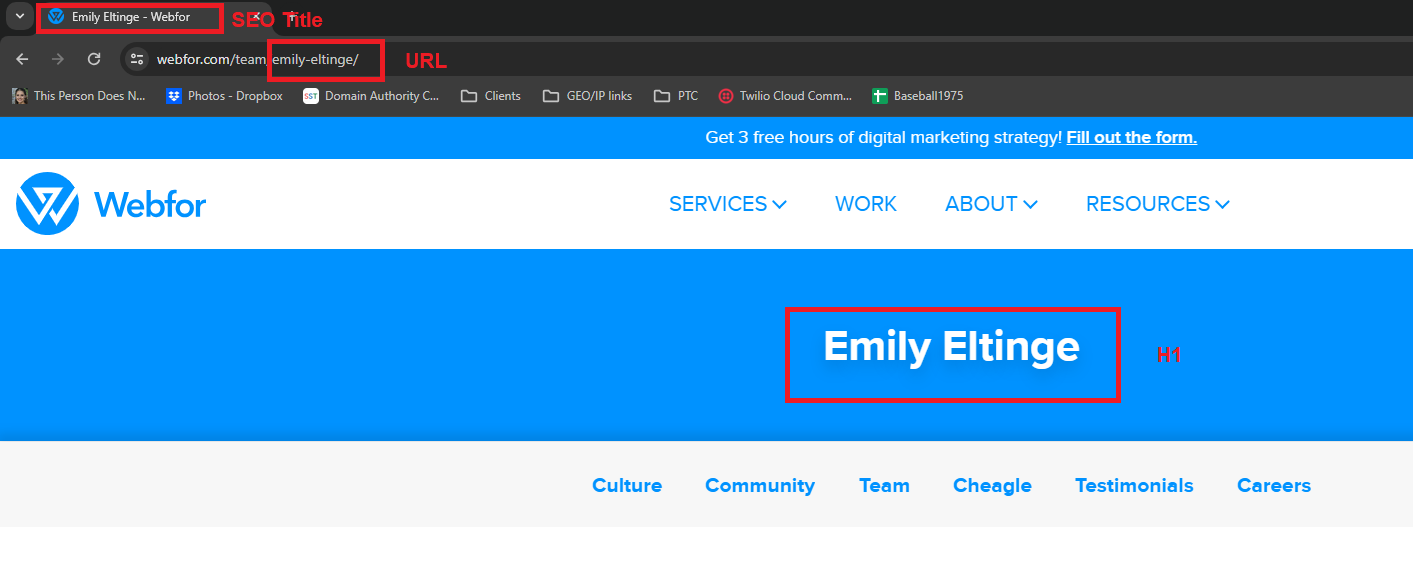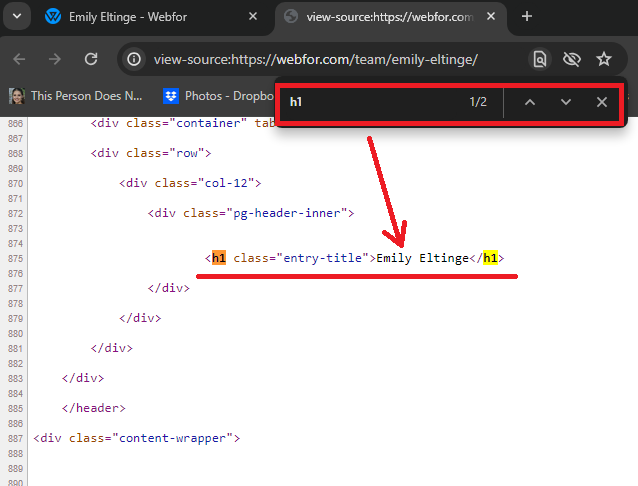If you want to grab additional page 1 real estate for yourself, you’re going to love this “About Me” strategy for online reputation management.
This do-it-yourself strategy is good for business owners and employees alike who are trying to push down negative content for their personal name.
And you can do it on your own, by following the tips below.
- How The “About Me” Strategy Works
- For Employees, Start Here
- Interview Questions Template (With Example)
- How To Optimize Your Page
- “About Me” Strategy Wrap Up
How The “About Me” Strategy Works
This online reputation management strategy is good for you if you meet either of the following criteria:
- You are a business owner and already have a website
- You are the employee of a company who has a website
The way it works is you create a lengthy piece of unique content, a single page, that is all “About You” and then publish it to your business website or your employer’s website.
The content will be in the form of a third person interview and done correctly, will help push down any negative links in Google by using basic SEO fundamentals which I’ll show you.
It’s a strategy you can implement yourself and I’m going to give you step-by-step instructions for how to do it.
Start by watching the video below, then read ahead for the detailed instructions, including an interview template you can use.
Since many employer websites are usually aged, they have a lot of domain authority.
If you follow this strategy (and can get your employer to agree to it), you will have created a great piece of content that should rank well in Google.
For Employees, Start Here
If you are the employee of a company, read this section.
If you’re a self-employed business owner, skip this section and go the next section.
How To Get Your Employer To Help You
If you’re the employee of a company, you’re going to need to get your employer to agree to allow you to post a profile page on your website.
My advice is simply to ask them.
You can suggest that allowing employees to have their own page on the company website is a great way to showcase the experience, talents, and personal side of their employees.
By showcasing each employee, it gives your customers and clients a better chance of connecting with you, which can help increase revenue.
Expand On “Meet The Team”
Many small businesses already have a “Meet The Team” page which give a brief profile of it’s employees.
Below is an example of this from the web design company, Webfor.

Notice how each employee (even the company dog) has a nice image with their name and title below.
But now look what happens, when you click on the bio for one of the team members, Emily Eltinge.
She has her own bio with background, education, and what she likes to do outside of work.

Now, let’s Google Emily’s full name and see what the search results look like.

Look at this!
Emily’s bio page on the Webfor website ranks #2 when you Google her name.
It is only outranked by her LinkedIn profile.
This is exactly what you want to see.
Of course, I chose Webfor and Emily at random; she is not a client.
Now that you can see the benefits of the “About Me” strategy, let’s take a look at how to create a great page.
Interview Questions Template (With Example)
While the page for Emily is only 150 words long, it still ranks well on Google.
But longer content almost always ranks better, so I recommend completing a bio page that is at least 1,000+ words.
So, you’re probably wondering, how do I create a 1,000 words of content about myself.
Well, here’s a template you can use.
Interview Template For “About Me” Page On Company/Business Website
- Opening Bio (write in third person, 250 words long)
- How did you get started in this business? (answers to this all questions below should be at least 75 words and be unique)
- How does your company make money?
- How does your company go about acquiring new customers?
- How did you work your way up in this business?
- What made you want to work in this industry?
- What is it that you feel makes you good at your job?
- What are the perks of working in this type of business?
- What are the disadvantages of working in this field?
- What’s the most rewarding part of your work?
- Where is your industry headed?
- What excites you about the future of this line of work?
- What advice do you give people who want to get into your field of work?
- What do you enjoy doing in your time away from work?
- What are your favorite hobbies?
- Your LinkedIn Page URL (this helps your LinkedIn rank better, too)
Feel free to replace any of the questions with your own.
Make sure each of your answers is about 75 words.
You’ll wind up with over 1,000 words of robust content that should rank really well.
Of course, it goes without saying, don’t copy/paste any of your answers, they should be 100% unique and not published anywhere else on the web.
You might also like: Reputation Management For Small Businesses
The template above is from the interview website Inspirery, which I own.
And here’s an example of an interview for one of the business people featured on the site: https://inspirery.com/diego-avalos/.
Notice the lengthy opening bio and how each question is followed by long answers.
Okay, now that you’re armed with the template, let’s make sure you optimize your profile page, so it ranks high on Google.
How To Optimize Your Page
By now, you’ve gotten approval to publish a page and you know how to write a great profile.
Now let’s optimize it following each step below, so it ranks highly when you Google yourself.
1. Optimize SEO Title to include personal name
The SEO title is also known as the page title and it’s the most important signal you can send Google to tell what a web page is about.
You can see any SEO title when you hover your mouse over the tab for any web page.
In the example shown below for Emily, you can clearly see her full name appearing in the title.

2. Optimize slug (URL) to include personal name
The “slug” is the part of the URL that trails the domain name and any folders.
Look at the example above and you can see Emily’s name is perfectly optimized within the URL for the page about her.
It appears right after webfor.com/team/.
3. Optimize H1 tag
The H1 tag stands for “Heading 1” and it’s probably the second most important indicator to Google for what a page is about.
Refer back to the example above to see the H1 for Emily which appears at the top of the page.
You can view an H1 tag by viewing the page source for any page.
Simply right click your mouse, then click “View page source.”
This opens a new window.
In this new window, do Ctrl-F and search for H1 to find the H1 tag for the page.
Here’s how it looks on Emily’s page:

Pro tip: Make sure there is only one H1 tag on a page.
Having multiple H1’s is a no-no because it confuses things – Google’s algorithm won’t know which H1 is the most important.
4. Name in content
Without being spammy or unnatural sounding, use your name within the opening bio.
Back to our example with Diego, notice how his name is the first thing mentioned.
His full name is mentioned twice and it looks natural.
I wouldn’t recommend more than 2-3 uses of your name.

5. Make it long
Longer pages rank better, most of the time.
So, to give yourself the best chance of a creating a high ranking page, make it long.
I recommend 1,000 words or more.
Recapping the advice above, you can do this by providing a long opening bio and lengthy answers to each question.
Pro tip: Another way to get your name into an interview is to provide third person quotes within your content, such as: Your Name said, “Your quote.”
6. Keep it unique
If you’re doing serious online reputation management work, you’re going to want each page of content you produce to be 100% unique from every other page of content.
Don’t copy and paste and don’t do rewrites.
If your bio already appears on the web in other places, make sure that what is on your new “About Me” page is different.
Google’s algorithm is not going to rank two pages with very similar content well.
It will pick one to rank and disregard the other one.
“About Me” Strategy Wrap Up
I think what I love most about the “About Me” strategy is it doesn’t require you to spend a dime.
All you’re doing is creating a great page about yourself which is going to rank well on Google for your name.
It works because most business websites have been around awhile and have domain authority.
This is a strategy you can implement yourself, whether you have negative links you want to bury, or you just want to create some positive PR for yourself.
Wishing you the best of luck and just reach out and contact us if you need help.
